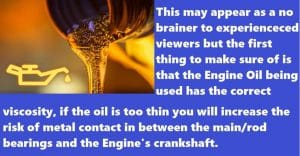Are you having problems with your car’s engine not starting? Have you been having trouble starting your lawn mower? If you answered yes, you might be experiencing low oil pressure. Low oil pressure is a common issue that can affect many machines and is often the result of various issues.
In this post, I’ll discuss the causes and solutions for low oil pressure and provide some helpful tips to help you fix it as quickly as possible. So, without further ado, let’s get started!
What Is Low Oil Pressure?
Low oil pressure is a warning light on the dashboard of most cars and trucks that appears when the oil pressure lowers below normal. It refers to an engine or vehicle not supply with enough oil to work properly.
Moreover, low oil pressure can result from various mechanical problems, some more likely than others. It inhibits oil from reaching engine bearings, piston rods, and other parts. If there isn’t enough oil, oil-lubricated or four-stroke gasoline engines can fail.
What Causes Low Oil Pressure?

Low oil pressure means the engine does not provide enough oil to work properly. While there are a number of ways that low oil pressure can result, the most common cause is a worn or damaged oil pump. Now, I’m sharing some most common causes of low oil pressure light in the vehicle.
Burning Oil Smell
Burning oil smell is one of the top causes of low-pressure engine light. Engine oil serves as a friction reducer between two moving parts and the oil pump circulates this oil in the engine to ensure everything runs smoothly. The burning oil smell indicates excessive wear and tear on engine components.
Noisy Engine
A noisy engine is a fundamental sign of low oil pressure. If the engine is noisy and spills water or oil, especially near the crankshaft, it may have low oil pressure. Another common cause of noisy engines is damaged piston rings and cylinder liners. Worn items can pull away from the cylinder walls, causing damage to the valves and pistons below. It can result in noise and leaks.
Excessive Oil Consumption
One of the more common signs of low oil pressure is excessive oil consumption. Depending on the vehicle, this might mean that oil is not reaching all parts of the engine. It could also mean a leak in the oil line or oil pump. While many motorists assume that low oil pressure equals low fuel economy, this is not always true.
Excessive Oil Leaks
The amount of oil lost from a vehicle over time is low and varies with both the oil’s quality and the external environment. Uneven wear and added friction are two factors that can increase this amount. However, more leaks and drips can occur in the engine, especially near the crankshaft, indicating low oil pressure.
The engine Doesn’t Run Smoothly
Low oil pressure may also cause the engine to run rough. If there isn’t enough oil circulating, the pistons and valves can’t move smoothly and it will cause the engine to run roughly. It could also cause the engine to shudder or shake. If there is insufficient oil for the oil pump, there isn’t enough oil flow to the engine, causing it not to run smoothly.
Strategies for Fixing Low Oil Pressure

Now that you’ve learned some of the most common causes of low oil pressure, you should take steps to repair your car and restore the low-pressure engine light.
Engine Diagnosis: The first step to repairing low oil pressure is having a mechanic check the engine. On modern vehicles, there will usually be a warning light for the oil-pressure warning system. A mechanic will run tests to determine if the low oil pressure is an engine or warning system problem. Most mechanics will run a compression test to determine if there are any cracks.
Replace Oil Pump: If changing your oil doesn’t work, you may need to buy a new engine pump and replace it yourself. A new oil pump can be a relatively easy fix. You should also repair any worn or damaged camshaft bearings and piston rings while replacing the oil pump.
Add Oil Pressure Gauge
Adding an oil pressure gauge can also help to determine what is causing low oil pressure. If you have any mechanical knowledge, you can install an inexpensive gauge yourself on most automobiles. Connect the gauge to your vehicle’s oil line with internet clamps, pass the wire through a dashboard grommet, and drive.
FAQs
How Do I Change the Oil in My Car?
It depends on the make and model of your vehicle. In most cars, the oil pan is accessible from the top and you loosen the oil plug and remove it. You can also buy a plastic part on any auto parts shop that has the same function as the original one.
Is It Safe to Run On the Low Oil Pressure?
Yes! Low oil pressure is very safe if it’s not leaking. The engine will build up heat and that is what causes the high pressure to leak out. Most oil changes are done at about 1,000 miles or 2-3 quarts of oil. So you’ll be fine to run on the low oil pressure up to that point.
Do I Need to Change My Oil Regularly?
“Yes! Many engine components cause wear and tear over time and deterioration. If you never change the oil, you could damage your engine due to excess wear and tear. Even if you don’t have any problems with your vehicle, it’s a good idea to change your oil every 3,000 miles or every 3 months.
Final Discussion
You may have realized that low oil pressure can affect everything from your mower to your vehicle. But don’t worry! There are steps you can take right now to prevent it from happening again in the future.
And, always be sure you’re using quality oil and keeping track of the miles on your vehicle. Before spending extra money, make sure it’s an emergency to check the oil level and perform routine inspections.

As a mechanical engineer, it’s easy for David to explain the functionality of the tool. David test most of the tools before writing a review. its help him to learn something new and suggest the best product for you.





